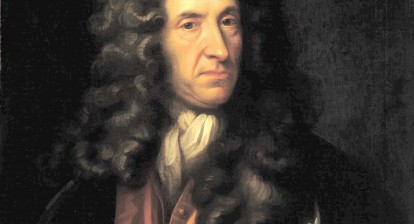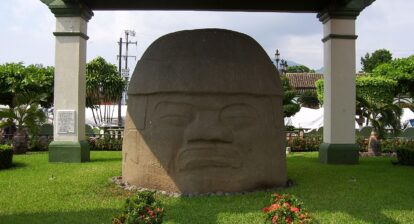Blogpost/Transcript
Everyone knows about the Roman Empire – and why not, they ruled over a large part of the world and immensely influenced western civilisation. But Italy existed before the Romans made it their own and it comprised of a variety of cultures and people.
One of these were the Etruscans – a culture that flourished in Italy between the 9th and 3rd century BCE and formed the most powerful nation in pre-Roman Italy. They deeply influenced the Romans and their influence on present-day western cultures is also now being recognized. The toga, forever the symbol of Roman men, was an Etruscan invention.
Much of Etruscan culture and history was either destroyed by or assimilated within the Romans, who eventually conquered them. Surviving archaeological evidence such as tombs, wall paintings and statues and the fact that the Romans adopted many of their practices, even their architecture point to the influence on and contribution to the Mediterranean region of this – Italy’s first great civilisation.
The Etruscan civilisation at its greatest extent covered a territory encompassing what is now Tuscany, western Umbria, and northern Lazio, as well as parts of Po Valley, Lombardy, and Campania. Their land, Etruria, lay in central Italy with the Tyrrhenian Sea on the west and the Arno River on the north. The Tiber River formed the eastern and southern boundary.
The Greeks called them Tyrsenoi or Tyrrhenoi and the Latins referred to them as Tusci or Etrusci. Twentieth BC Greek historian Dionysius of Halicarnassus suggested that the Etruscans called themselves Rasenna.
Globally, the iron age began anywhere between 1200 to 600 BCE depending on the region and continent. In Italy it began in 1100 BCE with what is known as the proto-Villanovan Culture. In actuality, this was the start of Etruscan civilisation. The earliest evidence we have of Etruscan culture is from 900 BCE from central Italy, the start of what is now known as Villanovan proper. As Villanovan, the people exploited natural resources (including wood from forests and metal ores such as iron and copper). The region formed into villages and by 750 BCE when it had developed into full Etruscan, major cities were established. The Etruscans started to establish themselves as the most successful population group in the Mediterranean. The independent city states were associated with each other through a common culture, language and religion. All the cities evolved independently and there are significant differences in progress in manufacturing, art, architecture, and government systems. During the period between 600 to 500 BCE, an alliance of 12 city-states was formed, known as the Etruscan League.
People mined copper and iron and the copious supply of forest wood in the region enabled them to build ships. The Etruscans became famous for their maritime activity, dominating the seas in the western coast of Italy and becoming infamous as pirates. Their main occupation however was agriculture. They were also connected to other Mediterranean city states through trade in pottery, metals, agricultural products, and mineral resources.
Most of what we know of the Etruscans is from Greek, Roman, Egyptian, and Middle Eastern sources. No Etruscan literary works have survived. They traded with and were influenced by Greece and the Middle East, as has been inferred from objects imported into Etruria and from the Greek influence on Etruscan artifacts.
The Etruscan language does not survive in literary works, it had ceased to be spoken by the time of the Roman Empire, although it was still studied by priests and scholars. It was used for religious purposes till at least 410 CE, when Etruscan priests were brought into Rome to conjure lightening against the invasion of Alaric, chief of the Visigoths. It did not work.
Over 10,000 Etruscan inscriptions have been discovered to date, most of which are funerary or dedicatory inscriptions, found on ash urns and in tombs. Some engravings have been found on Etruscan mirrors, coins, dice, and pottery. One of the most famous inscriptions is that of the Zagreb Mummy wrapping, found in the 19th century in Egypt and taken to Yugoslavia. Originally a linen book, it was later cut up to be wrapped around a mummy. The inscription comprises of 1,300 words, written in black ink and is the longest text yet discovered. It contains a calendar and instructions for religious sacrifice. The best example of deciphering the Etruscan language is the inscription on gold plaques from the ancient sanctuary of Pyrgi. These are in Etruscan and Phoenician, helping to decipher the language. Also, the plaques provide historical information, recording the dedication in the 5th century BCE of a sacred place in the sanctuary, to the Phoenician goddess Astarte, by an Etruscan king.
(Mother Goddesses – When Women Were Worshipped)
There has been a myth that the Etruscan language has not been deciphered and this is not true. Their alphabet derives from the Greek alphabet and the Latin alphabet ultimately borrowed from the Etruscan one. The problem arises not because the language has not been deciphered but because it is difficult to understand its meaning and grammar. It is not an Indo-European language and so no other language is closely related to it. Still, it was not completely isolated and has commonalities with many Indo-European and non-Indo-European languages from western Asia, east-central Europe and the central Mediterranean. Its different structure means it can just not be classified as any of the currently known language categories.
There is however a lack of Etruscan literature, so archaeologists rely on funerary, urban, and sacred artefacts to understand Etruscan history, culture, and religion. For example, the remains of a city at Marzabotto shows that the city was laid out in a grid, making the Etruscans among the first in the Mediterranean to do so. Eventually, the Romans adopted this method, calling it ritus etruscus and it exists in many present-day cities in Europe. Examples of tombs from the 6th century BCE, found at Caere, show that they resemble actual Etruscan houses, with windows, doors, columns, ceilings and even furniture. Tombs found at Tarquinii are replete with frescoes showing funerary celebrations, perhaps depicting the afterlife.
The Etruscans believed that human life is just one part of the larger cosmos, controlled by a pantheon of gods and their main god was Tin. According to Roman writers, the Etruscans regarded all plants, animals, and birds as sources of knowledge of the gods. And these gods had communicated through a prophet called Tages, a child with the features of an old man, who sprang out from a ploughed furrow. The various deities that inhabited the sky, manifested through natural phenomena, such as lightening, and revealed their intentions and requirements through the entrails of animals. So, the art of divination, or augury, by using these entrails was exceedingly popular. Some of the gods were later equated with the Greek and Roman ones.
Based on Greek accounts, especially of Herodotus, it was believed that the Etruscans originated in Lydia in Anatolia (modern day Turkey) and migrated to central Italy. However, it is also thought that they were a local culture that emerged and gradually evolved in Italy before the Romans took over. Other theories suggest that these people migrated into Italy from the north. There are of course the aforementioned Greek and Middle Eastern influences through trade, and people migrating from the Levant and Greece. None of these confirm the origins of the Etruscans. Perhaps they were all interrelated and influenced the civilisation, just as the civilisation influenced others.
Etruscan women had more freedom than their Greek and Roman counterparts, formed an integral part of the family unit, were educated, could own property, and even participated in public life. Initially, Etruscan government was a monarchy, which then evolved into an oligarchy. Males of certain clans had higher status in society and dominated key roles in politics and religion.
Etruscan culture went into decline from the 6th century BCE. The seventh and final Roman king, before the establishment of the Roman republic, was Lucius Tarquinius Superbus, an Etruscan migrant, who reigned from 535 BCE, until he was overthrown in 509 BCE, initiating the decline of the civilisation. The Etruscans also experienced losses to their marine fleet and attacks on their ports by the early 5th century BCE. And then other Italian tribes started taking over. The Celts also infiltrated and overpowered Etruscan communities by the mid-fourth century BCE. Eventually, they were completely submerged into the growing power that was Rome, in the 4th century BCE. The end came in 90 BCE, when Rome granted citizenship to all Italic people, effectively eliminating the autonomy of existing Etruscan city-states. Wars, brutal Roman colonisation and land grabbing added to this change. By the time of Augustus Ceasar in 31 BCE, the Etruscan language was completely overtaken by Latin.
The Romans would adopt and adapt Etruscan architecture, their victory processions that evolved into the Roman triumph, their divination practices and of course the toga. And their language donated many words to other languages in Italy, as well as influencing the Runic script of northern Europe.
So, next time you read about the Romans, remember there were people in Italy before them: the Etruscans.
(Check out the post on Persepolis – City of Persians)
I hope you enjoy the post and video. You can subscribe to the You Tube Channel for more on science, history and nature and please do check out the website and follow on social media: Twitter // Instagram // Facebook // Reddit // Tiktok. You can check out the audio podcast on: Apple Podcasts // Stitcher // TuneIn // Spotify
The selected Optin Cat form doesn't exist.






